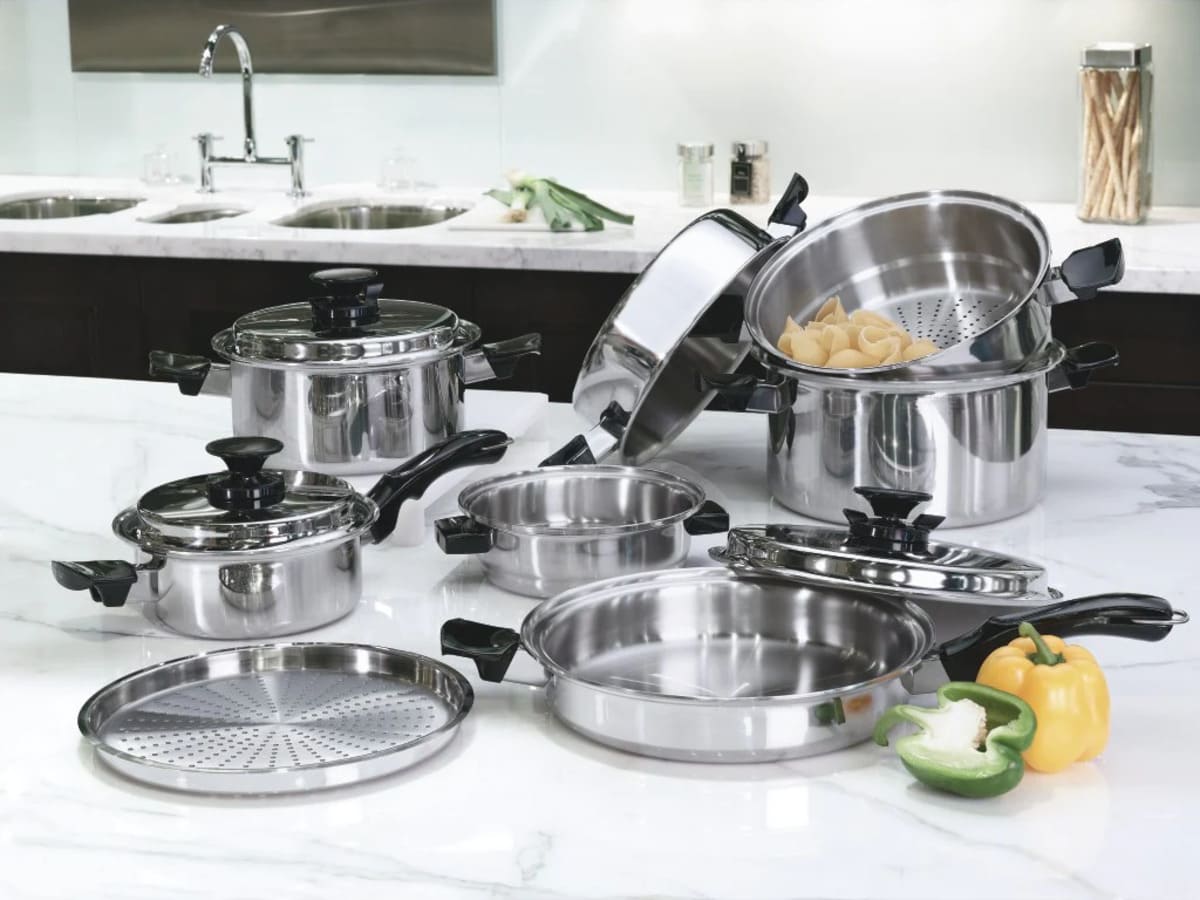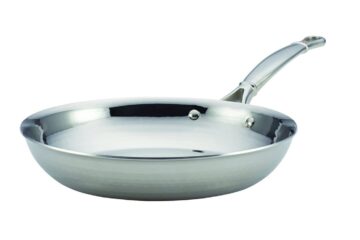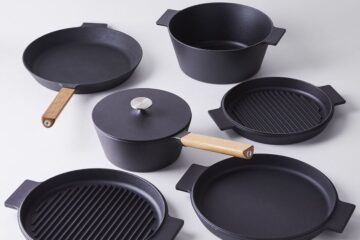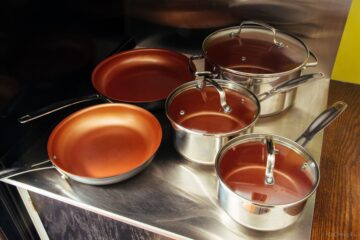With iconic brands like Le Creuset and Staub, heritage style cookware refers to high quality, heirloom-worthy pots and pans built to last decades. Known for even heating, durability, and timeless style, this cookware commands a premium price.
But is heritage cookware worth the investment? Or are more affordable options like Lodge or Caraway a better fit for most home cooks?
After extensive testing and research, the answer is yes – heritage cookware is absolutely worth saving up for if you cook frequently. Keep reading this in-depth guide to understand why and how to choose the right heritage cookware to suit your needs and budget.
We’ll cover popular heritage cookware brands, materials like cast iron and ceramic, pricing differences, care and maintenance tips, and do a side-by-side comparison to help you invest in pieces you’ll treasure for years.
An Overview of Heritage Cookware Brands and Materials
Heritage style pots and pans prioritize quality materials and craftsmanship. This high-end cookware aims to perform better and last longer than average kitchen gear.
The most iconic heritage brands include Le Creuset and Staub from France and Smithey Ironware Co. in America. Lesser known brands like Great Jones and Caraway also offer heritage inspired designs.
These companies put care into selecting premium materials like cast iron or ceramic. Then, they craft pieces with attention to detail – from pouring enameling to polishing finishes.
Let’s explore the benefits of these key heritage cookware materials:
Cast Iron
Cast iron pots and pans excel at retaining and distributing heat evenly. This makes them ideal for searing, browning, baking, and frying. The more you use cast iron, the more it “seasons” and improves over time.
Popular cast iron styles include:
- Dutch Ovens – Ideal for braising, soups, stews, and bread. Deep sides help circulate heat.
- Skillets – From frying eggs to searing steaks, skillets excel at cooking versatility. Choose your size.
- Grill Pans – Ribbed grill pans let you get grill marks indoors.
Enameled cast iron offers easy cleanup by coating the porous surface with a glossy enamel that won’t react with acidic foods.
Ceramic
Ceramic cookware stands out for its natural non-stick cooking ability. The ultra smooth ceramic surface lets you cook with little to no oil and makes cleanup a breeze.
Ceramic excels at cooking delicate foods like eggs or fish that may stick to cast iron. And it heats up and cools down quickly.
Popular ceramic cookware includes:
- Frying Pans – Ceramic frying pans handle eggs, pancakes, and more without sticking.
- Sauce Pans and Stock Pots – Boil or simmer sauces or soups without scorching.
- Bakeware – Some brands offer ceramic casserole dishes, cake pans, and more.
While the non-stick ceramic surface makes cooking and cleanup easier, it’s less durable than cast iron and not ideal for high oven temperatures.
Now that you know the benefits of cast iron versus ceramic, let’s compare popular heritage cookware brands and product lines.
Top Heritage Cookware Brands and Collections
With an overview of materials, let’s see how the top brands compare for design, quality, and price.
Le Creuset
If money is no object, Le Creuset enameled cast iron reigns supreme for luxury heritage style pots and pans.
Founded in 1925 in France, Le Creuset established itself as a premium cookware brand known for their superior heat distribution and vibrant colors.
Their cast iron Dutch ovens epitomize Le Creuset. Round or oval, these heavy, substantial pots excel at slow cooking flavorful stews, soups, and more. Their sizes range from 1.25 qt up to a massive 13.25 qt to fit any need. With the proper care, these Dutch ovens easily last decades and become family heirlooms.
“This Le Creuset 5.5 qt Dutch Oven exceeded my expectations. The heat distribution is amazing. Soups and stews cook so evenly without hot spots or burning. Clean up is easy. And it looks gorgeous in my kitchen!” – Sarah M.
In addition to Dutch ovens, Le Creuset offers enameled cast iron skillets, braisers, grill pans, stock pots, and more. Their stoneware bakeware and dishes also receive high marks.
Most reviewers agree Le Creuset is worth the splurge. You’ll treasure these heirloom-quality pieces.
However, some find Le Creuset simply too heavy. And minor cracks in the enamel do occur over time with improper use. Avoid metal utensils and temperature shocks to prevent damage.
Le Creuset nearly matches premium brands like Staub for quality yet costs even more. If you love their colors and designs, the investment may be worth it for you.
Staub
For a high-end brand at slightly lower prices, Staub cast iron impresses nearly as much as Le Creuset.
Founded in France in 1974, Staub established itself as a competitor to Le Creuset with high standards for quality enameled cast iron cookware.
The key difference lies in the interior surface. Where Le Creuset enamels all surfaces with a smooth glossy coat, Staub leaves a matte black enamel inside their pots and pans. Tiny pores help create a natural non-stick effect over time as you cook with oil.
For braising, stewing, roasting, and baking, Staub’s cast iron Dutch ovens excel. Their sizes range from 2 qt up to 7 qt. With fewer colors to choose from, Staub looks slightly more understated than Le Creuset.
Reviewers praise Staub’s ability to cook evenly with impressive heat retention. But a few complain of some enamel chipping over the years. Proper care helps prevent chips.
Overall, Staub delivers almost identical cooking performance to Le Creuset for around 15% less cost. Staub makes an excellent high-end heritage brand choice.
“I love my Staub 5 qt dutch oven! I’ve used it weekly for the past 5 years to cook soups, braised meats, bread, and more. It still looks brand new. The matte enamel interior gives it a nice non-stick effect too.” – Jena A.
Beyond Dutch ovens, Staub sells cast iron skillets, grill pans, roasting pans, and kettle pots to round out your kitchen. Their graphite and dark colors lack Le Creuset’s vibrancy but offer understated elegance.
Lodge Cast Iron
If premium prices above $200 make you balk, Lodge cast iron delivers excellent heritage style cookware at budget-friendly prices.
Made in America since 1896, the Lodge company keeps their cast iron production old-school. They’ve perfected the process of molding, seasoning, and polishing cast iron over decades.
At around $20-75 per piece, Lodge costs a fraction compared to Le Creuset and Staub. However, cooking performance nearly rivals the premium brands.
Lodge cast iron skillets remain top-sellers for their versatility to fry, sear, bake, and more – all at a great value. Their 10.25 inch skillet costs just $20.
Seasoning the bare cast iron interior takes some work initially but improves over time. Avoid soap and metal utensils on the surface.
“I was shocked how well this $20 Lodge skillet performed. The heat distribution rivals my mom’s fancy Le Creuset skillet. For the price, you can’t beat it.” – Lucas T.
In addition to skillets, shoppers love Lodge’s Dutch ovens, grill pans, griddles, and more. Note that the unfinished, bare cast iron requires quite a bit more maintenance than pricey enameled models. But Lodge provides a lifetime durability guarantee for defects.
For budget-friendly cast iron cooking, Lodge delivers quality and value. Just expect to put in some elbow grease keeping it seasoned.
Smithey Ironware Co.
If you desire heirloom level cast iron with a sleek, modern aesthetic, Smithey Ironware ups the design factor.
Founded in Charleston, South Carolina in 2015, Smithey merges old school cast iron craft with contemporary design. Every piece gets polished to a smooth, glossy finish akin to expensive enameled cookware.
Aesthetically, Smithey pans feature rounded corners, integrated handles, and hammered surface finishes. The designs look gorgeous.
Performance-wise, users praise the even heating and natural non-stick surface that develops after seasoning. The smooth polished interior makes Smithey easier to care for than traditional Lodge cookware. Prices range from $100-200 per pan.
Given the premium design and cost, Smithey sits between Lodge and Le Creuset or Staub for pricing. Their modern heirloom-quality cast iron impresses lovers of form and function.
“Smithey nailed it – this pan looks stunning and performs even better. Expensive but worth it if you cook often and want beautiful cookware”. – Miles A.
In addition to the popular skillet and Dutch oven, Smithey sells specialty pieces like a grill pan, chicken fryer, and braiser. Their quality and design justify the investment for frequent home cooks.
Caraway
Switching gears to ceramic, Caraway Home makes non-toxic, non-stick ceramic cookware in eye catching colors.
Launched in 2018, Caraway set out to deliver non-stick performance without using harmful coatings like PFOA or PTFE. Their frying pans and sauce pans feature a ceramic-coated aluminum core for responsiveness and even heating.
Style-wise, Caraway pots and pans make a statement. Their speckled ceramic coating and colored anodized aluminum bodies pop nicely against stainless steel handles and lids.
For cooking, users praise Caraway’s non-stick ability to fry eggs with ease and boil sauces without burning or scorching. The lightweight design also makes Caraway user-friendly.
However, some caution the cookware can’t handle high heat. Warping or degrading coatings result above 400F-450F. Gentle to medium heat works best.
With sets starting around $395-$525, Caraway costs substantially less than premium cast iron. Overall, they deliver quality ceramic non-stick performance.
“After years of buying cheap non-stick pans, I’m thrilled with my Caraway purchase. They cook so evenly and I don’t need any oil or butter. I don’t see these degrading over time like cheap pans.” – Lauren R.
If you want non-stick ability, bright colors, and lower maintenance than cast iron, Caraway excels. Their ceramic frying pans and pots suit most cooking needs.
Just take care not to overheat them. With light to medium stove use, Caraway earns rave reviews.
Great Jones
For another contemporary, stylish take on ceramic cookware, Great Jones offers their own colorful Dutch ovens and frying pans.
Founded in 2018 in Brooklyn, NY, Great Jones melds eye-catching colors with sleek design. Their enamel cast iron pans offer a more traditional take on heritage style cooking. But their ceramic non-stick pans and pots deliver modern, playful flair.
Reviewers praise Great Jones’ ceramic for even heating and cooking eggs easily without oil. The ceramic doesn’t degrade as quickly as cheaper options.
Style-wise, Great Jones pots come in rich shades of blue, green, and red. Thick stainless steel handles contrast nicely and add durability.
Prices sit around $95-$165 for frying pans and sauce pots – on par with Caraway. Expect similar performance with a bit more design edge from Great Jones.
For a fun, contemporary option, Great Jones excels. Both their enameled cast iron and ceramic collections impress home cooks. Plus they offer a lifetime warranty.
“I absolutely love the look and feel of these Great Jones’ ceramic pots. The non-stick surface makes cooking and cleaning so much easier too.” – Julia D.
How to Choose: Cast Iron vs. Ceramic Cookware
With popular brands covered, should you pick cast iron or ceramic for your kitchen?
Here’s a comparison of key pros and cons:
Cast iron pros:
- Heats evenly for amazing browning and searing
- Can be used on all cooktops including induction
- Gets better over time as it seasons
- Will literally last decades or generations with care
Ceramic pros:
- Provides an easy to clean, non-stick cooking surface
- Heats quickly and evenly
- Tempered glass lids make it easy to monitor food
- Wide variety of bright, trendy colors
For slow cooking tasks like braising roasts or soups, enameled cast iron excels. Dutch ovens from Le Creuset, Staub, or Lodge evenly circulate heat and develop fond beautifully.
Ceramic frying pans work best for cooking delicate foods like eggs or crepes that need a slick non-stick surface. Caraway and Great Jones ceramic prevents sticking.
Cast iron skillets handle searing or frying with responsive heat across their surface. Consider Lodge or Smithey.
Maintenance and care is easier with ceramic. Cast iron requires regular seasoning. Le Creuset and Staub enamel makes cleaning simple but costs much more.
And cast iron withstands oven temperatures up to 500F+ while ceramic degrades above 400-450F.
Pick cookware suited to your cooking style, needs, and maintenance preferences. And mix different materials – like using enameled cast iron for braising and ceramic for eggs.
Cost Comparison – Budget to Premium Heritage Cookware
With an overview of materials and brands, let’s compare prices across the heritage cookware landscape.
Here’s an example price comparison for a popular 5-6 quart Dutch oven across brands:
- Le Creuset Dutch Oven – $300+ for a 5.5 qt oven
- Staub Cast Iron Dutch Oven – $280+ for a 5.25 qt oven
- Smithey Dutch Oven – $200 for a 6 qt oven
- Lodge Cast Iron Dutch Oven – $75 for a 5 qt oven
- Great Jones Dutch Oven – $155 for 5.5 qt oven
- AmazonBasics Enameled Cast Iron Dutch Oven – $60 for 6 qt
As you’ll notice, Le Creuset and Staub cost over 3-4x more than budget options from Lodge and AmazonBasics.
You pay a steep premium for attractive colors, branding, and premium materials like heavier cast iron. But the cheaper brands lag on style points.
Mid-range picks like Great Jones and Smithey offer nice compromises of quality and aesthetics.
Consider your budget – and keep in mind pricier cookware should last exponentially longer. Cheaper brands like Caraway may degrade or warp sooner.
For the best value, Lodge cast iron provides amazing quality for under $100 per piece. Their vintage styling appeals to many as well.
Think about your cooking frequency too. Daily home cooks may appreciate spending up for Le Creuset’s beauty and durability. Once-a-week cooks can save with Lodge or AmazonBasics.
Care and Maintenance Tips
To get the most out of your investment in heritage cookware, follow these care and maintenance tips:
Hand wash only – Over time, dishwashers can degrade cast iron enamel or ceramic coatings. Hand washing preserves quality.
Avoid harsh detergents – For cast iron, mild soap and warm water work best. Ceramic can handle a bit more soap. Avoid abrasive scrubbers.
Dry immediately after washing – Letting pots and pans air dry can lead to rust for cast iron. Always hand dry.
Don’t let it soak – Allowing cast iron or ceramic to sit wet for hours leads to staining. Quick cleanup avoids this.
Season cast iron regularly – After cleaning, spread a thin layer of oil on bare cast iron to maintain the seasoning.
Use silicone, wood, or plastic utensils – Metal utensils like forks can scratch the surfaces over time. Soft utensils protect your cookware.
Don’t use cookware empty – Heating up an empty pan, especially at high heat, can damage coatings. Always add a bit of oil or food first.
Avoid temperature shocks – Big swings from very hot to cold can crack enameling. Allow cookware to cool more gradually before washing.
Store mindfully – Avoid stacking pots inside each other. This prevents chipping rims or enamel.
Following these tips, you’ll keep your heritage cookware performing like new for many, many years. Quality brands like Le Creuset and Lodge truly do last decades or longer.
Is Heritage Cookware Worth Investing In?
Let’s circle back to the overarching question – with premium prices, is heritage style cookware worth buying compared to average pots and pans?
Here’s the bottom line:
Yes – quality heritage cookware that fits your cooking style is absolutely worth saving up for.
Pieces like Dutch ovens, skillets, and frying pans from brands like Le Creuset, Staub, Lodge, or Great Jones will serve you reliably for decades, if not generations.
The even heating, durability, and timeless styling live up to their reputation.
While cheaper cookware will degrade, stain, or warp much sooner, properly cared for heritage cookware improves with age. Like a good cast iron skillet that keeps getting better.
Given how often you may use pieces like skillets or pots for essential cooking tasks, investing in heritage quality makes sense.
Of course, more casual cooks may balk at splurging on Le Creuset. And that’s fair. Consider more affordable options from Lodge and Great Jones in that case.
For cooking enthusiasts or anyone that loves cooking with carefully crafted tools, heritage cookware brings joy and convenience to daily kitchen use.
At the end of the day, assess your budget, cooking needs, and how often you’ll use heritage cookware when making your purchase decisions.
Opting for a cheaper pan makes sense if you won’t use it often. But frequent cooks get life-long value from Le Creuset and other heritage brands.
The vintage styling and colors also bring charm to your kitchen. Heritage cookware becomes a beloved tool rather than just another pan.
While not cheap upfront, the durability delivers better long-term value than replacing cheaper pots and pans every few years.
Heritage cookware also makes wonderful gifts for weddings, new homes, birthdays, and holidays. Share the joy of cooking with beautifully crafted pots and pans.
Whichever brand and style you select, heritage cookware graces a kitchen. These pots witness family memories as they contribute a lifetime of use.
Enjoy Your New Heritage Cookware
We hope this guide makes choosing heritage style cookware easier.
Determine your budget, cooking needs, and preferred materials like cast iron or ceramic.
Brands like Le Creuset, Staub, Lodge and Great Jones each offer quality heritage cookware to suit different tastes.
Remember to care for your cookware properly to enjoy it for decades to come. Treat it well and it will treat you and your family well at dinnertime!
Happy cooking with your new heritage cookware! Let us know if you have any other questions.




